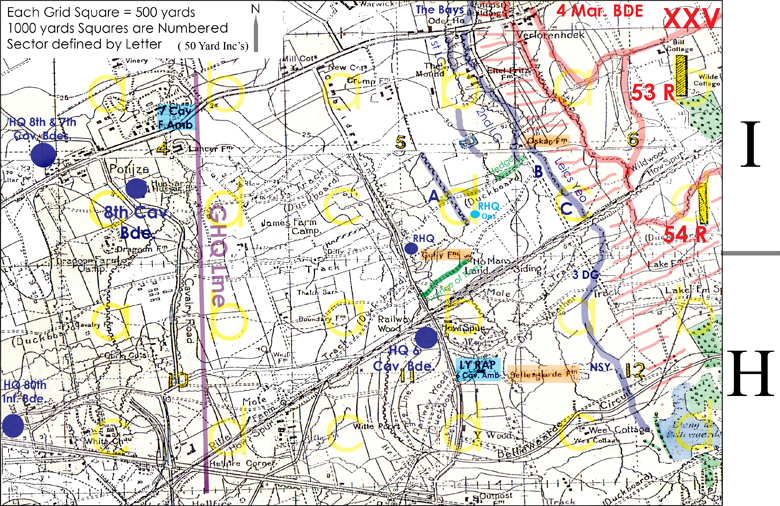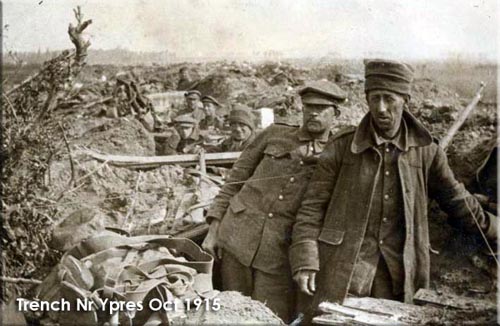Total Number: 15 Officers & 267 NCO's and men
went into battle on the 12th May 1915.
RECORDS OF LEICESTERSHIRE YEOMANRY
on the nights of
May 12th and 13th. 1915,
When they held the
trenches to the East of Ypres against the attack of the
Germans.
At 5pm on May 12th
when in huts 1 mile wst of Ypres on the Brailen Road and
one mile East of that Village, an order came to march
for the trenches at 7.15. All respirators were inspected
and doped, and the Regiment, consisting of 281 all ranks
moved off from the huts at 7.30 in Brigade with 1st
and 2nd Life Guards, the Leicesters being the
leading Regiment.
The route taken was
East along the VLAMERTINGE-YPRES Road through the town
of YPRES. The town was being shelled by Germans during
our march through and was practically all on fire.
The Brigade left
YPRES by the ZONNIBEKE Road and passed through the
village of POTIJZE, and about ½ a mile further East
halted for half an hour near white Chateau, on left of
road West of General Head Quarter Line and West of where
brook crosses Road.
At 11pm we marched
off to take up our position in trenches previously
occupied by the 5th Battalion Royal Fusiliers
and situated about 700 yds West of the Road joining the
Zonnebeke Road and the YPRES MENIN Rd (squares 5 & 6,
sheet 28 Squared BELGIUM map) with the extreme Right of
Regiment resting on Railway running North East from
Ypres and extending to farm house about 300 yds North
North West of Railway including trench in front of Farm
House.

The map above is accurate.
B squadron occupied
North portion of trench C squadron the South portion of trench.
The trenches were
bad, about 5feet deep and 2 ½ feet wide at bottom, the
parapet in front and behind trenches slanted very much
and was made of loose soil, very few sand bags being
used. There were no dugouts of funk holes (the friable
nature of soil would not allow of their being made) so
there was practically no protection from shell fire.

The support trenches
occupied by A squadron were situated about 300 yds to
the front of advance trenches and on the extreme flank
of B squadron.
The M.O. and R.A.M.C
were 1st in support trenches but were
subsequently (2 am) ordered by C.O. to make Regimental
Aid Post in Farm situated 200 yds South of Railway.
Crossing on left side of Toad in square 11 opposite
wood. This Farm was found to be occupied by 6. Cav.
Field Amb. as their advanced dressing station.
The 7th
Cav. Field Ambulance had its advanced dressing station
at White Chateau on the YPRES. ZONNEBEKE Rd. ½ mile East
of POTIJZE Village.
The Hd. Qrs. were in
dugout on Rd. joining ZONNERBEKE and MENNIN Rd. about
150 yds North of Railway crossing.
All troops got
settled down in their trenches about 1 am some
difficulty being experienced in finding best positions
for machine gun and it was ultimately placed in C
squadron trenches close to Rly.
At 1.30 spades and picks were
obtained and the men improved the condition of their
trenches during the night.
There were no trench
bombs or mortars or hand grenades issued to the
Regiment.
The 3rd
Dragoon Guards occupied trenches on immediate South of
the Railway, and the 1st Life Guards the
trenches immediately North of B squadron.
Between 3.30 and 4 am
the Germans commenced a very heavy shell fire - shrapnel
and high explosives - on both the advanced and support
trenches which practically continued without
intermission till 6 am when there appeared to be a lull.
The casualties during that time were not very heavy, and
were attended to by the stretcher bearers who had
accompanied each squadron with their stretchers into the
trenches, Pte Townsend did excellent work in this
respect in support trenches.
At about 6.15 there
was signs of a German assault and some Germans left
their trenches when a heavy rifle fire from our advanced
trenches caused the Germans to retire precipitously to
their trenches and open again a heavy shell fire upon
our trenches, but principally confined this time to the
advanced trenches, and they continued shelling till
7.30.
During this shelling
there were many casualties, principally in the advanced
trenches and the trenches themselves were blown flat,
especially that in front of the Farm on the extreme Left
of B trenches and the Germans seemed to be getting into
trenches which had been occupied by the 2nd
Life Guards and evacuated by them before 6 am and coming
along there trenches towards B squadron trenches.
The B squadron
gradually retired South along their trenches, some
leaving trenches and retiring to support trenches.
The Germans continued
their advance along B squadron trenches and leaving
trenches advanced West under cover of hedge, until they
came to within 200 yds of the support trenches and here
dug themselves in a ditch which ran parallel with
support trenches and it was noticed that the Germans
used steel shields to protect their advance. Here they
remained till the counter attack in the afternoon.
More Germans
continued to advance along B squadron trenches and also
made frontal attack under cover of their snipers, and
B
squadron retired on C. When they came to the left of
C
squadron they found Major Martin in Command, and he
rallied the B and ordered barricades to be built across
the trenches and he himself and SGT. MAJ. Swain defended
these barricades by rifle fire. Major Leibert who
commanded the B squadron was killed about now.
Major Martin was
perfectly cool and collected, cheering his men by his
undaunted courage and example got his men to make a
great stand against large odds. This stand continued
some time, the rifle fire of the Germans being very
heavy, especially by snipers from front and flank Major
Martin and Sgt. Major Swain and others standing behind a
traverse and shooting Germans coming along trenches,
whilst Lieut. Brooks and others protected their front
from the German advance.
This check to the
Germans continued for some time, and casualties from
rifle fire were very heavy, among them were Lieut.
Brooks, shot through the head until Major Martin was
killed whilst making an observation of the advancing
Germans support with his glasses.
He was shot through
the upper part of face by a near range bullet and killed
immediately.
Lieut. Johnson and
Sgt. Major Swain and 14 men (all that now remained in
the advance trenches) retired fighting along trenches to
the Railway passing on their way the remains of the
Machine Gun which seemed to have been knocked out by
shell fire.
At the Railway Lieut.
Johnson had a pit dug for cover as they dare not cross
the Railway as it was reported to machine fun fire by
the Germans.
Lieut. Johnson and
Sgt. Major Swain got into communication with the 3rd
Dragoon Guards, five men of whom attempted to cross the
Railway to assist the Leicester Yeomanry two of the
Dragoon Guards were killed in the attempt.
An attempt was then
made to build a barricade across the Railway from both
sides in order for the Leicesters to effect junction
with the 3rd Dragoon Guards. This was done
leaving only a short space in the centre of the Railway
exposed to Machine gun fire, and Lieut. Johnson, Sgt
Major Swain and 14 men of the Leicesters with the 3
surviving Dragoon Guards rushed across behind this
barricade singly and at intervals, and suffered only 2
slightly wounded in the passage.
These men were now in
the trenches occupied by the 3rd Dragoon
Guards and here they found Capt. Hanbury unwounded and
under him started to make a barricade parallel with the
Railway to prevent the 3rd Dragoon Guards
trenches being enfiladed by Germans on Left. Capt.
Hanbury was wounded whilst in these trenches. They
remained here till 8 pm when they retired with the
general retirement of 3rd Dragoon Guards.